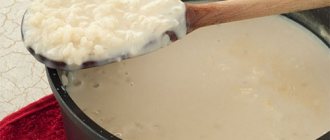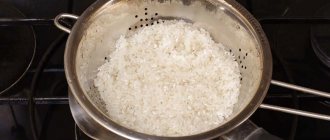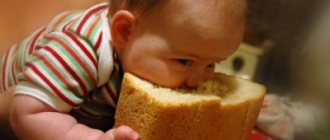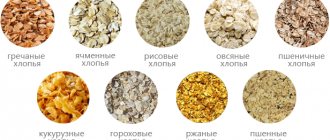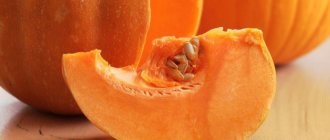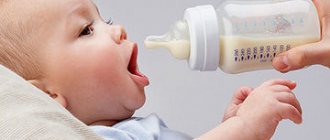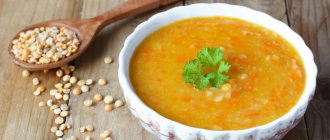Winging porridge
There is nothing easier than cooking delicious rice porridge that any child will happily eat. Just take the “Kuban” rice “National”. White round polished grains of soft varieties are the key to success. Bring 150 ml of water to a boil in a saucepan, add 50 g of rice with a pinch of salt and cook until swollen. Then pour in 150 ml of hot milk and cook the rice until cooked. At the end, add a slice of butter with 1 tsp to the porridge. honey Grate half the apple and add to the porridge when it has cooled a little. Before serving, lightly sprinkle it with cinnamon - the seductive aroma will definitely whet your child's appetite.
An excellent option for first feeding: rice porridge, and how to prepare it for a baby
From about six months of age, the child begins to be fed. The baby is offered porridge as the first adult food.
They saturate the body with nutrients and give a boost of energy.
Rice porridge for babies is considered one of the useful ones.
Rice contains a lot of valuable components necessary for the normal functioning of the body. For example, it contains a lot of vitamins B, PP, E, N. It is a source of complex carbohydrates. Rice contains sufficient amounts of zinc, iron, phosphorus, iodine, calcium, selenium, and magnesium.
Today there are about 150 varieties of this cereal. But not all varieties make tasty milk porridge. Long-grained varieties come out crumbly when cooked.
Medium-length rice produces a sticky, but not sticky, porridge. Round varieties of cereal are recommended for making mousses, soups and casseroles.
They make a delicious porridge with milk. It is the round varieties that are recommended to be chosen for preparing dishes for infants. Rice also comes in white and brown. The latter variety is considered more useful. It has a higher concentration of complex carbohydrates and minerals.
In particular, there are many B vitamins, which are needed to ensure energy exchange and good condition of the coronary vessels. There is practically no salt in this cereal crop. Its calorie content in the form of porridge is approximately 90 kcal per 100 g of product.
Rice porridge for babies is useful for the following:
- protects the stomach and intestines from irritation. Achieved due to the ability of rice to envelop the mucous membrane;
- strengthens the immune system, which is quite weak in infants;
- ensures normal formation of bone tissue and teeth;
- has a beneficial effect on the course of metabolic processes;
- replenishes energy costs. Babies are actively growing and developing. To ensure the normal course of this process, they need strength;
- prevents the development of vitamin deficiency;
- removes toxic compounds from the body. This has a good effect on the functioning of the kidneys, stomach and intestines;
- ensures normal development and function of the myocardium;
- helps increase muscle mass;
- increases hemoglobin, prevents the development of anemia;
- activates brain function, stimulates mental development;
- has a beneficial effect on the condition of the epidermal integument;
- ensures the normal formation and functioning of the nervous system.
In the period up to one year, the baby grows and develops rapidly. At this time, he needs a daily supply of nutrients. Rice porridge satisfies these needs.
Pediatricians especially recommend including rice in the diet of children who are prone to diarrhea. Cereals have a binding effect. Enveloping properties prevent digestive problems.
At what age can complementary foods be introduced?
Rice is well absorbed by children's bodies. Therefore, this cereal is suitable for preparing porridges for babies. Infants begin to be introduced to adult food from about six months of age. Artificial children are introduced to complementary foods from 4-5 months.
Pediatricians advise starting to introduce your baby to adult food with gluten-free cereals . Gluten is poorly digested by the child's body, causing allergic reactions. Experts recommend starting complementary foods with buckwheat and rice.
How to cook rice for a baby?
Round rice is worth choosing for making puddings, milk porridges and casseroles. The medium-sized grain is suitable for light side dishes. Steamed cereal is ideal for pilaf. There are two ways to prepare rice porridge for babies: from whole grains and from grains ground into flour.
The latter method is more convenient and simplifies preparation. You can grind a certain amount of cereal and then take small portions of it for cooking. In the recipes below, milk means breast milk or adapted milk formula.
Milk porridge made from rice flour:
- 20 grams of rice;
- baby water (about 50 ml);
- half a glass of milk.
Cooking algorithm:
- Grind rice cereal to flour in a coffee grinder;
- put the product in a bowl and fill with cold water;
- put on the stove and bring to a boil. Cook for five minutes, stirring constantly. Add milk;
- turn off the heat and remove from the stove.
Whole rice milk porridge:
- milk – 120 ml;
- rice - half a glass;
- baby water - a glass;
- butter - half a teaspoon.
Cooking algorithm:
- rinse the cereal and boil it in water;
- cool and grind in a blender or using a sieve;
- add milk;
- put on fire and boil for about 10 minutes, stirring occasionally;
- add oil and cool.
Whole rice porridge
It is convenient to cook rice milk porridge in a slow cooker. To do this, 100 g of cereal is washed and placed in the bowl of the device. Add a glass of water and the same amount of milk.
Mix everything with a special spoon and set the “milk porridge” mode. After the process is completed, turn on the “heating” function for 15 minutes. The finished dish is mixed and then ground, adding butter.
Porridge made from rice flour is more homogeneous. This is an ideal option for the first feeding of 4-5 month old babies. Children from six months of age can be given pureed porridge.
Recipes for children's dishes based on rice
Rice is used in the preparation of not only porridges, but also casseroles and meatballs:
- curd and rice casserole . For a one-year-old baby, you can make a curd-rice casserole. You will need about 250 g of cottage cheese, two tablespoons of sugar, 100 g of round rice, 50 g of raisins, two tablespoons of yogurt or kefir, and a chicken egg. To grease the baking dish, you will need a piece of butter. Boiled rice must be mashed with cottage cheese with a fork. Add egg, kefir, salt, raisins. Mix everything thoroughly and place in a baking dish. Place in the oven for 40-60 minutes. You can prepare curd and rice casserole in a slow cooker;
- rice porridge with apple . Infants can be given rice porridge with apples. To prepare it you will need two tablespoons of cereal, ground in a coffee grinder, one apple and a small piece of butter. All components must be combined and simmered over low heat for a quarter of an hour;
- apple iceberg in a sea of rice. When a child is closer to one year old, you can prepare an interesting and tasty dish called “Apple Iceberg in a Sea of Rice.” The ingredients you will need are one apple, two tablespoons of rice flour, a couple of plums and a few black currants. Rice must be poured with 150 ml of water and boiled for five minutes. Then add the berries and plum pulp and simmer for about 5 minutes. Bring the cooled porridge to a puree using a blender;
- rice with fish . You will need 50 g of hake fillet, two tablespoons of ground rice, 20 g of carrots, a teaspoon of butter, onions (10 g). Rice, vegetables and fillet must be boiled. Combine all components and grind in a blender. Add salt to taste. Add broth and bring to a boil. The dish turns out tasty and healthy.
Until 12 months of age, the dish should be ground through a sieve. Children after one year are allowed to give lightly crushed boiled rice.
Rice porridge is not suitable as a daily complementary food. It is recommended to give rice to babies 1-2 times a week. If a child is prone to constipation, then he should be offered rice no more than once every 7-10 days.
Excessive consumption of rice porridge can lead to hypocalcemia and problems with bone tissue. This is explained by the presence of fluorine in the composition, which at high concentrations interferes with the absorption of this mineral. Also, the frequent presence of rice in the diet can lead to persistent constipation.
Rice porridge is usually well tolerated by the baby's body. Negative reactions are possible only to sugar and other additives. Therefore, porridge should be prepared from harmless ingredients. It should be taken into account that some babies are allergic to rice protein.
Infants should gradually include rice porridge in their diet. First, the baby is offered a teaspoon of the dish. If within two days there are no negative changes in the baby’s health, then the single portion is increased. By the age of one year, the volume of porridge is increased to 100 grams.
Kaleidoscope in salad
A salad with rice, vegetables and ham will successfully diversify the children's menu. Here, the long-grain rice “Jasmine” “National” feels most organic. Snow-white soft grains perfectly retain their shape when cooked, acquiring a pleasant aroma and delicate taste. Boil 100 g of rice until al dente and drain in a colander. Cut 50 g of turkey ham into thin slices. Cut red bell pepper into cubes, 1 cucumber into thin strips. Combine vegetables with ham, rice and 80 g of canned peas. You can add grated cheese. We dress the salad with natural unsweetened yogurt if desired and decorate with fresh herbs.
Top 6 best manufacturers of baby cereals
| Product/manufacturer, price | Characteristics (age of the child at which the first complementary foods are introduced - from 4 months) | Range of products sold |
| FrutoNanny (Russia), from 80 rub. for 200 g | The dish is enriched with prebiotics, antioxidants, vitamins and minerals. |
|
| Humana (Germany), 350 rub. for 250 g | Rice porridge for first feeding without added gluten and sugar contains 13 vitamins, calcium, iron, iodine. |
|
| HIPP (Croatia), 175 rub. for 200 g | The dish does not contain GMOs, dyes, preservatives, flavors, gluten and sugar. |
|
| Nestle (Switzerland), 120 rub. for 200 g | The dish contains refined rice, which is well absorbed by the stomach. Product without GMOs, dyes, preservatives. |
|
| Bebi, from 100 rub. for 250 g | The product contains 12 vitamins, iron and iodine. |
|
| Heinz (USA), 125 rub. for 250 g | Without salt, sugar, preservatives, flavorings. One-component, does not require cooking. |
|
Air cutlets
Even zealous picky eaters will not refuse hearty rice cutlets. Especially if you make them from “Japanese” “National” rice. This white round-grain variety has an important feature - its grains have increased stickiness. Boil 150 g of rice in salted water, combine with 100 g of flour, 1 egg, 2 tbsp. l. sour cream, a pinch of salt and knead the dough. Form cutlets, roll in ground bran and bake in the oven for 20 minutes at 180°C. At this time, fry grated zucchini in a frying pan with a chopped clove of garlic, 1 tbsp. l. flour and 2 tbsp. l. sour cream. Puree the cooled mass with a blender. This vegetable sauce will successfully complement rice cutlets.
The benefits and harms of rice for first feeding
The best for first feeding are gluten-free porridges - buckwheat, rice, corn; they do not contain potential allergens (cereal protein gluten). Rice porridge is good for infants because it contains vitamins and carbohydrates and is perfect for a child with unstable stool.
It is allowed to introduce the first complementary foods to infants from 7-8 months, and to children on artificial formula from six months of age. It is important for parents to consult with their local pediatrician. Benefits of rice porridge:
- contains 8 amino acids used to build new cells;
- accelerates growth and other physical indicators of child development;
- strengthens the nervous system, the structure of hair, nails, bones;
- normalizes intestinal motility;
- helps eliminate toxins in allergies;
- strengthens local immunity;
- stimulates the mental development of the child (lecithin activates brain activity).
When choosing rice porridge as a first complementary food (while breastfeeding), young parents should remember the potential harm of a natural product:
- strengthens the intestines;
- interferes with the body's absorption of calcium and iron;
- can provoke intestinal colic in the baby's tummy.
Delicious hedgehogs
Rice goes perfectly with meat, and delicious hedgehogs are a prime example of this. To make them tastier, use “Giant” “National” rice for cooking. This is a large variety of rice that is traditionally used for risotto and paella. It perfectly absorbs the aromas of other ingredients and has a creamy taste. Cook 200 g of rice in salted water until half cooked, mix with 500 g of minced beef, an egg, a pinch of salt and pepper. We make hedgehogs and brown them in a frying pan with butter on all sides. Next, place them on a baking sheet and put them in the oven for 30 minutes. A suitable side dish for them would be fluffy mashed potatoes or fresh vegetables.
Rice for children: benefits, recipes, recommendations
Rice cereal is a healthy hypoallergenic product that promotes the rapid harmonious development of a child. A well-fed baby becomes energetic, active, and explores the world with pleasure. Rice for a one-year-old child can be prepared in many ways; without a doubt, the baby will like many dishes.
At what age should children be given rice?
It is recommended to postpone the first acquaintance with porridges - corn, rice or buckwheat until the age of 6-7 months. During this period, the child’s body is already ready for such food. Except in the following cases:
- the baby suffers from constipation;
- the baby is obese - rice will speed up the child’s weight gain;
- The baby suffers from colic. Eating rice will make the problem worse.
At what age can a child have rice, each parent decides independently, after consulting with a pediatrician.
The optimal period for introducing rice into the diet depends, among other things, on the type of feeding.
- For breastfed babies, rice is recommended no earlier than 6-7 months.
- Artificial babies can be given rice a little earlier.
Rice, like most foods for first complementary feeding, must be introduced into the baby’s diet slowly, gradually. Carefully monitor your body's reaction. If there is no negative reaction, administration can be continued.
The benefits of rice for a baby
Rice is perfect for first feeding. Thanks to its starch-mucous structure and enveloping effect, rice porridge has a beneficial effect on the child’s gastrointestinal tract and protects the stomach from irritation.
Rice is especially useful for children prone to diarrhea. Rice cereal has a pronounced strengthening effect.
Nutritionists say that rice porridge is the most tender and best suited for complementary feeding. Even for babies with sensitive digestive systems. For little ones, rice porridge is also preferable because it does not contain gluten. Cereals are considered the optimal substitute for wheat.
Rice for children aged one year and older perfectly replenishes energy costs and is an important source of minerals and proteins.
The product contains: potassium, calcium, magnesium and phosphorus, as well as folic acid, carotene, thiamine, 8 essential amino acids.
Porridge is rich in complex carbohydrates, which help maintain the child’s muscle strength. When prepared correctly, porridge will satisfy hunger for a long time and give your baby pleasure from the meal.
Which rice is healthier for a child?
The most popular in our latitudes are short-grain, medium-grain and long-grain rice. Less commonly prepared are brown and steamed. These cereals are eaten by mothers on a diet, but they are in no hurry to give them to babies. And in vain. All types of rice are good in moderation.
- Short grain rice contains the highest amount of starch. The cereal cooks well, becoming sticky, soft, and creamy. Short grain rice is ideal for making casseroles and puddings.
- Medium grain rice sticks together much less when cooked, but absorbs the flavors of other ingredients very well. Also suitable for casseroles and soups. The product is recommended for children in moderate quantities.
- The long-grain variety cooks less than the others. Long and thin grains do not stick together during cooking. This type is universal and suitable for preparing any dishes.
- Brown rice is healthier than white rice. Grains with preserved bran shells retain more valuable substances. However, brown rice is coarser, more expensive, takes longer to cook, and has a shorter shelf life. Brown rice is recommended for children aged 9-10 months and older. At an earlier age, brown rice should be given only in pureed form.
- Parboiled rice is less valuable than brown rice, but healthier than white rice. It retains up to 80% of nutrients. The cereal is ideal for preparing pilaf. The grains do not stick together and do not lose their taste even when reheated.
Rice for children: recipes and cooking rules
Before cooking, rinse the rice thoroughly until the water becomes completely clear.
- It is recommended to soak round and medium grain grains for an additional 15-20 minutes in warm water, then rinse again in cold water.
- After washing long-grain and steamed, pour boiling water over it, and then pour cool water over it again.
How to cook rice for a child
When the rice is washed and processed, it needs to be ground and only then started cooking. You can grind the product in a blender or coffee grinder. Porridge for a child is cooked in water, milk or milk with the addition of water. It is better to avoid sugar in the dish, especially if you are preparing the dish for children under one year old.
The rice itself will add sweetness to the porridge. You can also add fruits or berries that are appropriate for the baby’s age.
In addition, rice goes well with vegetables, fish, meat, cream, cinnamon, and olive oil.
Age restrictions and the presence of allergic reactions must be taken into account!
To avoid problems with stool consolidation, it is recommended to boil the porridge in a decoction of fennel, prunes, and add pureed dried fruits. You can also feed your baby ready-made rice porridge, purchased in the baby food section of the store.
Rice porridge with pumpkin, recipe
Ingredients:
- 250 g raw pumpkin;
- 50 g white rice;
- 150 ml low-fat milk;
- a pinch of salt to taste;
- sweetener - honey.
Preparation:
- Wash the pumpkin, peel it, remove the seeds;
- cut the pulp into cubes, place in a saucepan;
- add pre-washed rice;
- add a little salt, stir, light the fire;
- cook 25 minutes, stirring frequently over medium heat.
Before serving, add a piece of butter and a teaspoon of natural bee honey.
How to store rice for children
It is equally important to know the rules for storing rice grains.
- Keep the cereal in a sealed jar away from sunlight and heat sources. Glass, earthenware or tin containers are preferred.
- Do not store rice for a long time.
- Make sure there are no bugs. For prevention, you can put a clove of garlic inside a jar of cereal. If insects have already appeared, we recommend throwing away this product.
Source: https://PitanieMalysha.ru/racion/ris-dlja-detej-polza-recepty-rekomendacii/
Pilaf with a twist
Little gourmets will not ignore the aromatic rice with chicken and persimmons. This is largely due to the white medium-grain rice “Adriatic” “National”. It deeply absorbs all the aromas and tastes, which is why the pilaf turns out so rich. In a deep frying pan, fry carrots, onions and 1 tbsp. l. grated parsley root. Add a cinnamon stick and 300 g of cubed chicken fillet and fry for 5 minutes. Next, pour in 200 g of rice, pour in 500 ml of chicken broth, cover with a lid and simmer until the liquid has completely evaporated. 5 minutes before the end, stir in the persimmon pulp in slices.
Sunny soup
The lunch menu will be enlivened by pumpkin puree soup. Complement it with long-grain polished rice “Selected” “National”. Its grains retain their shape when cooked and give the soup interesting flavor notes. Cook 250 g of rice until half cooked. We make a golden saute of onions and carrots in a saucepan. Add 350 g of pumpkin cubes to it, fry for a couple of minutes, pour in 1.5 liters of boiling water and cook until softened. Add the rice, cook right in the soup, let it cool and beat everything with a blender. Pour in 100 ml of cream and, stirring, simmer the soup over low heat for 2-3 minutes. Sprinkle the bowls of soup with croutons and chopped herbs, and the children will finish it in no time.
Pudding with a surprise
What is a children's menu without dessert? Delicate rice pudding “Krasnodar” “National” will bring special joy to children. This white, polished, soft-grain short-grain rice brings out the best in flavor when baked at home. Melt 50 g of butter in a saucepan and fry 100 g of rice for a minute. Pour in 600 ml of warm milk and cook the rice for 15 minutes. Grind 2 yolks with 50 g of sugar, and beat 2 whites into a fluffy foam. Add them one by one to the milk-rice mixture, add a handful of raisins and mix carefully. Fill oiled ceramic molds with this mixture and place in the oven at 190°C for 20 minutes. Little delicacies will be delighted.
Rice dishes are indispensable in children's diets. After all, they turn out not only tasty, satisfying, but also healthy. These qualities are most organically combined in rice of the National brand. With it you can constantly delight little gourmets with interesting dishes for every taste.
Rice for children
Rice is one of the first cereals introduced into the diet of babies. Why him? This is due to a number of properties of the product. We invite you to find out at what age it should be offered to a child, to whom it is contraindicated, which type of rice is healthier and how best to cook it. We hope that this information will help you raise a healthy and strong baby.
Which rice is healthier?
Did you know that there are more than 7,000 varieties of rice? It is grown in India and Vietnam, China and Indonesia, in some regions of Russia and other countries, including Asian and South American ones. Based on the color of the grains, brown, black and white rice are the most common. By size - medium-, round- or long-grain.
Brown rice is considered to be the most useful; it owes its color to the preserved husk, but it is in it that a significant portion of minerals and complex carbohydrates are concentrated - about 80%.
This product contains a significant amount of B vitamins, which have a positive effect on the functionality of coronary vessels and energy metabolism.
Brown rice is especially beneficial for people with allergies caused by a lack of gluten.
For diseases of the cardiovascular system and malignant tumors, it is advisable to eat “wild” rice; it is also called black because of its characteristic dark color. It is significantly superior to white and brown in terms of the content of nutrients, and thanks to its significant concentration of antioxidants, it supports the heart, helps fight infections, viruses and cell mutations.
Useful properties of rice
The value of rice lies in the fact that it contains almost all the substances necessary to maintain the vital functions of the body. Let's take a closer look at this point:
- Due to the significant content of B vitamins, in particular B9 (folic acid), rice has a positive effect on the hematopoietic system. It is useful to use when there is a low concentration of hemoglobin in the blood. In adulthood, this product reduces the risk of stroke or heart attack.
- It is recommended to eat rice to prevent magnesium deficiency. A lack of this mineral increases the likelihood of osteoporosis, the aging process of the body proceeds more intensely, and the risk of gaining excess body weight increases.
- Brown rice lacks sodium but does contain potassium. What is so good about it? Sodium helps retain fluid in the body, and potassium removes it. Due to this, the load on the heart is reduced, the likelihood of arrhythmia is reduced, and the heart muscle becomes stronger and stronger. If you have problems with the liver or kidneys, then you should completely abandon refined rice.
- Rice contains calcium, this mineral is strategically important for the formation of bone tissue, in particular teeth. It is also necessary for a balanced metabolism, and also has an anti-inflammatory effect, helps cope with allergies and strengthens the walls of blood vessels.
- Due to phosphorus, rice improves heart activity and normalizes metabolism.
- Unrefined grains contain choline, this is a special substance present in cell membranes, it is necessary for the correct functioning of neurons and nerve cells, increases their resistance to negative factors, helps the body cope with viral and infectious diseases, as well as those caused by toxins.
Rice contains less vitamins A and C than other foods, but this is not a problem because you can get them from vegetables, fruits and other grains. Unrefined grains contain significant quantities of insoluble and soluble fiber, due to which, with regular consumption, serious cleansing of the body occurs.
Rice does not contain gluten, which is found in all other grains, which means that it can be consumed by people suffering from celiac disease. Another advantage of this product is that it satisfies well, and after it you don’t feel hungry for a long time. It is these properties that have led to the inclusion of rice in many diets to get rid of excess fat.
Thanks to the presence of vegetable protein in rice, even 5 tablespoons of grains are enough to support muscles. Complex carbohydrates provide the body with energy reserves. Lecithin has a positive effect on the brain, and due to the enveloping properties of rice porridge, the acidity of gastric juice is reduced; this dish is useful for people with ulcers and gastritis.
At what age can children be given rice?
The optimal period for introducing rice into the diet of babies depends on the type of feeding. If a child is fed breast milk, it is better to postpone introduction to this product until 6–7 months. The baby is already on formula milk, which means you can gradually accustom him to rice porridge cooked with adapted artificial milk.
Rice is especially useful for children prone to diarrhea, as it has a pronounced strengthening effect. Thanks to its starch-mucous structure, this cereal is perfectly digestible and is perfectly accepted by babies. Due to the enveloping effect, digestive system disorders rarely occur. For this reason, rice is considered an ideal first food product.
Contraindications
For certain problems, eating rice is contraindicated. It should not be eaten in the following cases:
- if you are prone to constipation, this will only aggravate the problem;
- in case of severe obesity, rice can lead to additional weight gain;
- with colic, there is a high probability of increased pain.
Allergies to rice are extremely rare, but caution is a good idea. For the first time, offer your baby half a teaspoon of rice porridge, and only if the body’s reaction is normal, you can continue to accustom him to this product.
Rice pudding
Ingredients: 300 ml milk, 30–35 g rice (2 tablespoons), a pinch of salt, 20–30 g sugar, a pinch of ground cinnamon, a little whipped cream for decoration (optional).
Preparation:
- Bring milk to a boil, add rice and salt, reduce heat.
- Stir the dish constantly so that the rice does not stick to the bottom of the pan.
- 25 minutes after boiling, remove the pan from the heat, add sugar and ground cinnamon.
- Cook the pudding until it thickens, approximately 5-10 minutes.
- If desired, add raisins, then transfer to a mold and cover with cling film. Cool. The quantity of products is calculated for 1 serving.
Children's risotto
Ingredients: boiled chicken (from soup broth) - 50 g, 40 g rice cereal, 10 g butter, 5 g each of tomato puree and onions, 3 g each of flour and salt (by eye).
Preparation:
- Cut the chicken (can be replaced with veal) into cubes.
- Place the saucepan on the fire, wait until it warms up, pour vegetable oil into it, fry the peeled and diced onion in it (approximately 1/4 of the onion).
- When the onion is browned, add the rice to the saucepan and fry it lightly; it should turn yellow.
- Pour 2 tablespoons into the dish. spoons of broth, wait for it to boil.
- When the rice cereal becomes soft, add tomato paste and chicken (veal).
Serve hot, you can season with herbs.
Rice-pumpkin porridge
Ingredients: 250–300 g pumpkin, 50 g rice cereal, 100–150 ml milk, 1 teaspoon sugar, salt to taste.
Preparation:
- Peel the pumpkin and cut into cubes, then place them in a saucepan.
- Add rice to the vegetable, pour in milk, add sugar, add salt and stir.
- Cook for 20–30 minutes.
Before serving, season with butter and garnish with herbs.
Source: https://zen.yandex.ru/media/id/5b8e5927419fdb00abb9fce4/ris-dlia-detei-5bbae30f84802400aaeeaf12
